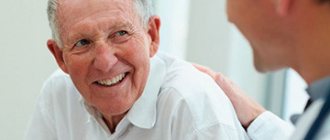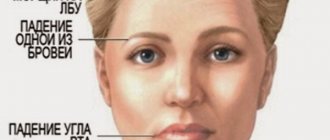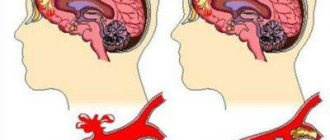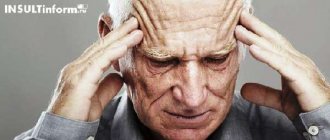What is a stroke?
Stroke is the absence of normal blood circulation in severe form or, in other words, stroke , manifested by the unexpected occurrence of a focal or cerebral neurological set of signs of this disease. The duration of the disease's impact on the body occurs within 24 hours and there is a very high probability that the disease will be fatal. There are three types of stroke:
- Brain infarction.
- Bleeding in part or all of the brain.
- Subarachnoid hemorrhages.
Literature
- Stakhovskaya L.V., Klyuchikhina O.A., Bogatyreva M.D., Kovalenko V.V. Epidemiology of stroke in Russia based on the results of the territorial-population register (2009-2010), 2013
- Kruchkov DV, Pavlova SV, Artamonova GV. Long-term survival in working-age patients after cerebrovascular accident, 2016
- Jangala MohanSidhartha. Risk factors for medical complications of acute hemorrhagic stroke, 2015
- Gülşen KOCAMAN,1 Hümeyra DÜRÜYEN,1 Abdulkadir KOÇER,2 andTalip ASİL1. Recurrent Ischemic Stroke Characteristics and Assessment of Sufficiency of Secondary Stroke Prevention, 2015
Main types of stroke
There are two main types of apoplexy: hemorrhagic and ischemic.
Hemorrhagic stroke is a severe lack of normal blood circulation or, in other words, a stroke with rupture of blood vessels and a large amount of blood entering the brain.
The cause of this type of stroke can be poisoning, lack of vitamins, anemia, bone problems, or an aneurysm. And the forecasts will be disappointing. This type of stroke is the most dangerous and difficult to tolerate, which is why the number of people who died from this disease is high. If you're lucky, you can live after this for just a couple of days. Brain damage in such a situation is not compatible with life, however, they are different.
For example, if the functioning of the left hemisphere is disrupted, speech disorders occur due to hemiplegia (paralysis of the limbs and muscles of the face and tongue), but if the functioning of the right hemisphere is disrupted, a person ceases to recognize others. But such disorders appear only when the lesions are not severe.
Ischemic stroke is the absence of normal blood circulation in a severe form or, in other words, stroke with injury to brain tissue , disruption of its functioning due to the fact that the flow of blood to the whole brain or its parts is stopped. In other words, a cerebral infarction. This type of stroke is the most common and has a high mortality rate. If a person has experienced an ischemic stroke 1 or even 2 times, then it is more than possible that he will not be able to endure the third. According to statistics, most patients fall into a state between life and death, without responding to external factors, for several days and, as a rule, do not come out of it.
Types of ischemic stroke include:
- Transistor attack of ischemic nature. As a result of the attacks, neurological disorders occur that disappear within 24 hours.
- "Minor strokes" They are similar to a full-blown ischemic stroke, but their symptoms subside within two days to three weeks.
- Progressive ischemic stroke, characterized by the development of stroke symptoms over several days. Functional restoration is not complete.
- Total ischemic stroke (completed). An established cerebral infarction with not fully regressing processes performed by the brain.
Symptoms
The symptoms of the disease are clearly expressed, so they can be diagnosed immediately and without difficulty. The signs of the disease are as follows:
- asymmetry in the face, the presence of a crooked smile;
- presence of weakness in the arms and legs;
- the patient cannot speak or speaks indistinctly;
- there are disturbances in coordination when moving;
- the patient complains of severe pain in the head;
- the patient cannot perceive the conversation of other people;
- his consciousness may be impaired.
It is very important to immediately call an ambulance when observing such symptoms in a person. His life and the consequences for him from this disease depend on it.
It should be noted that signs of the disease are observed in the patient earlier. If the following problems occur:
- headache;
- your head starts to feel dizzy;
- a person loses memory for a short time;
- with sudden movement it becomes dark in the eyes;
- There is a temporary feeling of disorientation in the room.
This is evidence of an impending major stroke. If you consult a doctor in this situation, you can avoid serious illness.
How is ischemic different from hemorrhagic?
To understand the difference between these two types, it is necessary to understand more carefully what they are.
An ischemic stroke , simply put, is when blood, due to a blood clot or other obstruction, does not flow to the brain tissue, as a result of which the tissue is weakened and does not “work.”
A hemorrhagic stroke is when part of the brain dies and the blood that should go there goes to the other side of the brain. Because too much blood accumulates, the vessels dilate and burst, causing bleeding in the brain.
The difference between them is easily perceptible. It should also be noted that with the second type of stroke the patient does not have the opportunity to live long, and with the first type he can even survive the first and second stroke if his health is in good condition. But even with excellent physical and moral condition, the third stroke will be severe.
Providing first aid
Often, when the initial single symptoms of an upcoming stroke appear, the patient requires first aid. What do these types of events include? First of all, if illness occurs, the patient must be taken out into fresh air, and it is advisable if he breathes deeply. Even if the patient gradually begins to feel improvements in his condition, this is not a reason to cancel the call to the ambulance team, since the person must undergo a thorough and complete examination in order to identify the main causes of poor health. This is especially true when stroke occurs in men.
In a situation where a patient shows signs of a brain stroke, he must be put to bed as soon as possible. If he loses consciousness, then positioning him on his back or side is excluded. Do not forget about the required amount of oxygen entering the lungs, and it will be better if he unbuttons his shirt and loosens his tie and belt. If possible, you can begin to reduce blood pressure through the use of drug therapy (those drugs that the patient had previously taken). Hospitalization in a medical institution in this case is extremely necessary, since the patient will need a full diagnosis, after which the most effective treatment will be prescribed.
Third stroke
As stated earlier, there are several types of stroke. Considering that the symptoms of an ischemic stroke allow a person to continue to exist for the longest period (compared to other types), this type of stroke is most suitable for consideration.
After experiencing the first and second stroke, the likelihood that a person will be able to return to his past life is small. On the way to this, health problems constantly arise. Disorders of the musculoskeletal system, sclerosis and persistent neuroses require inpatient observation and treatment. Often, due to lack of material resources, this is almost impossible.
In most cases, patients simply die in front of their families and doctors. You are no longer the same age and it is difficult to endure such torment. However, after the first major stroke, life is possible. Not full-fledged, but moderately active. After the second, it is difficult for a person to speak, walk, think and recognize friends and relatives, and some who have survived the disease twice completely lose the ability to walk.
Because a third stroke often has a detrimental effect on a person's health, most often resulting in death after several days in a coma, doctors who diagnose this disease often refuse to keep the patient alive. In most cases, when this happens to elderly people in a coma, they often suggest to relatives to perform euthanasia and save the person from suffering. They often refuse to keep the patient alive and tell him to wait.
Treatment and rehabilitation
According to accepted standards, after a patient is admitted to the neurological department, in addition to complex drug therapy, the necessary care and rehabilitation, which begins in the acute period, is of great importance. Starting therapy within the first 90 minutes increases the chances of success. A longer period reduces the effectiveness of therapy. The severity and extent of damage to brain cells determines how long victims are able to live.
Rehabilitation is a set of measures aimed at eliminating existing defects in a patient or adapting the patient to existing disorders. Neurorehabilitation is a powerful factor in the prevention of recurrent stroke.
Regular training, movement, and performing the necessary tasks are highly likely to prevent recurrent acute circulatory disorders and increase life expectancy after a stroke.
Rehabilitation in the acute period and in the first six months of treatment is accompanied by the greatest effectiveness. Social rehabilitation is also important for the patient’s recovery, including the ability to do without the help of loved ones and return to work capacity. In some cases, the consequences of a stroke are quickly eliminated, and after some time the victim is able to return to normal life.
In case of extensive lesions and severe stroke, rehabilitation is slow. Long-term and regular exercise therapy and exercises to normalize speech will increase the chances of success. Particular perseverance should be shown in the first months with a gradual increase in the intensity of classes.
The necessary treatment and a set of rehabilitation procedures are prescribed by a neurologist. After discharge, you should regularly follow the instructions at home. Rehabilitation in specialized centers can bring considerable benefits, where the patient will receive a set of measures for intensive recovery. Future life after a stroke depends on the quality of care provided. How many years people live after a stroke is determined by the completeness of restoration of lost abilities.
The complex of rehabilitation measures includes:
- physiotherapy,
- massage,
- classes with a speech therapist,
- walking training.
Place special emphasis on restoring those movements that the patient cannot achieve. An important role is played by the patient’s psychological attitude and the desire for a speedy recovery. Depression and lack of faith in the future delay improvements indefinitely. Relatives should strive to support the patient and encourage him to be active.
Elderly patients are the most difficult to rehabilitate.
It is difficult to say how long older people live after a stroke. Most often, after 80 years, it is impossible to restore the ability to move; the victim is often only able to lie down. This situation is characterized by the most unfavorable prognosis. Old age and immobility accelerate the decline of other vital functions.
Is it possible to cure
Treatment of recurrent stroke is a long process that requires not only the use of medications, but also rehabilitation measures.
The success of restoring impaired functions (speech, movements, self-care ability, vision, memory, mental activity) depends on the area of the lesion, the localization of the pathological process in the brain, the speed of providing medical assistance and other factors.
The likelihood of recovery depends on where the patient is treated. While in a hospital, a person is under constant supervision. The doctor regularly adjusts prescriptions depending on the person’s condition. It is much more difficult to do this at home.
When undergoing rehabilitation measures in a specialized clinic or sanatorium, the success of recovery increases. Physical therapy specialists work with the patient and select a set of exercises to restore muscle tone and activity.
However, even in case of recovery, you should be careful: do not be nervous, ensure proper sleep and rest, and eat a healthy diet. It is necessary to take all prescribed medications and be regularly examined by a neurologist, cardiologist and other specialists. This will minimize the likelihood of complications and increase the chances of a full recovery.










